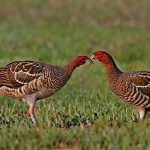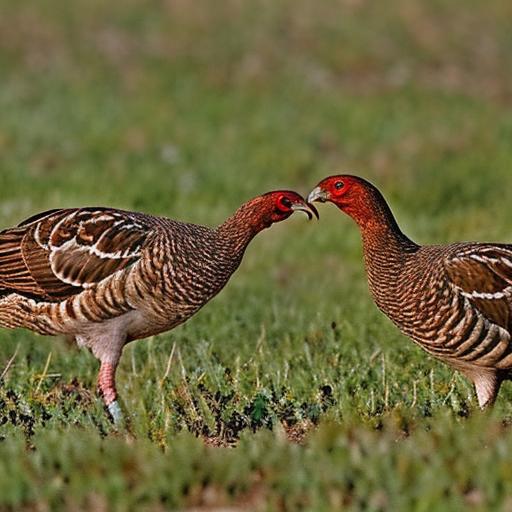Turkey breeding season is a crucial time for turkey farmers and breeders. It is the time when turkeys are encouraged to mate and reproduce, ensuring the continuation of the turkey population. The breeding season typically occurs in the spring, when the weather is warmer and the days are longer. During this time, male turkeys, known as toms, display their vibrant plumage and perform elaborate courtship displays to attract female turkeys, known as hens. The breeding season is essential for the production of turkey eggs, which are then incubated to hatch new poults. This period is vital for the sustainability of turkey populations and the production of turkey meat for consumption.
The turkey breeding season is a time of heightened activity and careful management for turkey farmers. It requires close monitoring of the turkeys to ensure successful mating and egg production. The breeding season is also a time for implementing breeding practices to maximize fertility and hatchability. Factors such as nutrition, housing, and environmental conditions play a significant role in the success of the turkey breeding season. Understanding the length of the breeding season, factors affecting it, and the importance of this period is crucial for turkey farmers and breeders to effectively manage their flocks and ensure a successful breeding season.
Key Takeaways
- Turkey breeding season typically occurs in the spring and early summer, when the birds are most fertile and able to reproduce.
- The length of the turkey breeding season usually lasts for about 4-5 months, allowing for multiple breeding cycles within a single season.
- Factors such as temperature, daylight hours, and nutrition can affect the turkey breeding season, influencing the birds’ reproductive behavior and success.
- The turkey breeding season is important for maintaining and improving the genetic diversity and overall health of turkey populations.
- Turkey breeding practices often involve artificial insemination, careful monitoring of breeding pairs, and providing optimal conditions for successful reproduction.
- Challenges during the turkey breeding season may include disease outbreaks, reproductive issues, and environmental stressors that can impact breeding success.
- In conclusion, the future of turkey breeding relies on continued research and advancements in breeding practices to ensure the health and sustainability of turkey populations.
Length of the Turkey Breeding Season
The length of the turkey breeding season typically spans from early spring to early summer, with the peak of mating and egg production occurring in the spring months. The exact duration of the breeding season can vary depending on factors such as geographic location, climate, and management practices. In general, the breeding season for turkeys lasts for several weeks, during which toms actively court hens and mating occurs. Hens then lay eggs, which are collected for incubation to hatch new poults.
The length of the turkey breeding season is influenced by natural factors such as day length and temperature. As the days lengthen and temperatures rise in the spring, turkeys are naturally stimulated to engage in mating behaviors. Additionally, the availability of food and resources can impact the duration of the breeding season. Adequate nutrition is essential for maintaining reproductive health in turkeys and can influence the length of the breeding season. Understanding the natural cues and environmental factors that influence the length of the breeding season is important for turkey farmers to effectively manage their flocks and optimize reproductive success.
Factors Affecting the Turkey Breeding Season
Several factors can affect the turkey breeding season, including environmental conditions, nutrition, genetics, and management practices. Environmental factors such as day length, temperature, and humidity play a significant role in stimulating mating behaviors in turkeys. As the days lengthen and temperatures rise in the spring, turkeys are naturally prompted to engage in courtship displays and mating activities. Additionally, proper housing and environmental conditions are essential for creating a conducive breeding environment for turkeys.
Nutrition is another critical factor that can impact the turkey breeding season. Adequate nutrition is essential for maintaining reproductive health in turkeys and ensuring optimal fertility and hatchability. A well-balanced diet that meets the nutritional requirements of breeding turkeys is crucial for supporting egg production and successful mating. Genetics also play a role in the breeding season, as certain breeds of turkeys may have different reproductive characteristics and behaviors.
Management practices such as flock health management, lighting programs, and breeding techniques can also influence the success of the turkey breeding season. Proper management of flock health, including disease prevention and control, is essential for ensuring that turkeys are in optimal reproductive condition. Implementing appropriate lighting programs to mimic natural day length can help stimulate mating behaviors in turkeys. Additionally, employing effective breeding techniques such as artificial insemination can be beneficial for maximizing fertility and hatchability. Understanding and addressing these factors is essential for optimizing the turkey breeding season and ensuring successful reproduction.
Importance of the Turkey Breeding Season
The turkey breeding season is of utmost importance for maintaining sustainable turkey populations and meeting the demand for turkey meat production. It is during this time that turkeys mate and produce eggs, which are then incubated to hatch new poults. The successful reproduction of turkeys during the breeding season is crucial for ensuring a consistent supply of turkey meat for consumption. Additionally, the breeding season allows for genetic diversity within turkey populations, which is essential for maintaining healthy and robust flocks.
The importance of the turkey breeding season extends beyond meat production to include conservation efforts for certain turkey breeds. Breeding programs aimed at preserving heritage or rare turkey breeds rely on successful reproduction during the breeding season to maintain genetic diversity and prevent population decline. Furthermore, the breeding season plays a vital role in sustaining the livelihoods of turkey farmers and breeders who rely on successful reproduction to maintain their flocks and meet market demands.
Understanding the significance of the turkey breeding season is essential for implementing effective management practices that support reproductive success in turkeys. By prioritizing proper nutrition, environmental conditions, and management techniques during this critical period, turkey farmers can ensure the sustainability of their flocks and contribute to the overall success of the turkey industry.
Turkey Breeding Practices
Turkey breeding practices encompass a range of management techniques aimed at optimizing reproductive success in turkeys during the breeding season. These practices include providing proper nutrition, managing flock health, implementing lighting programs, and utilizing breeding techniques such as artificial insemination. Proper nutrition is essential for supporting reproductive health in turkeys during the breeding season. A well-balanced diet that meets the nutritional requirements of breeding turkeys is crucial for supporting egg production and successful mating.
Managing flock health is another important aspect of turkey breeding practices. Disease prevention and control are essential for ensuring that turkeys are in optimal reproductive condition during the breeding season. Implementing biosecurity measures and vaccination protocols can help safeguard flocks from infectious diseases that could negatively impact reproductive success.
Lighting programs are often utilized to stimulate mating behaviors in turkeys during the breeding season. By manipulating artificial lighting to mimic natural day length, turkey farmers can encourage increased activity and mating behaviors in their flocks. This can help optimize reproductive success during this critical period.
In addition to these practices, some turkey farmers may choose to utilize artificial insemination as a breeding technique to maximize fertility and hatchability. Artificial insemination allows for precise control over mating outcomes and can be particularly beneficial for managing genetic diversity within turkey populations.
By implementing these breeding practices, turkey farmers can support reproductive success in their flocks during the breeding season and contribute to the sustainability of their operations.
Challenges During the Turkey Breeding Season

The turkey breeding season presents several challenges that can impact reproductive success and overall flock health. Environmental factors such as extreme temperatures or inclement weather can disrupt mating behaviors and egg production in turkeys. High temperatures can lead to decreased fertility and hatchability, while cold temperatures can pose risks to egg viability and poult survival.
Disease outbreaks are another significant challenge during the breeding season. Infectious diseases can spread rapidly within flocks, impacting reproductive health and leading to decreased fertility and hatchability. Implementing strict biosecurity measures and vaccination protocols is essential for mitigating disease risks during this critical period.
Genetic factors can also present challenges during the breeding season. Certain breeds of turkeys may have inherent reproductive characteristics that impact fertility and hatchability. Managing genetic diversity within turkey populations is important for maintaining healthy flocks and addressing potential challenges related to reproductive success.
In addition to these challenges, managing flock behavior and social dynamics during the breeding season can be complex. Aggressive behavior among toms or competition for mates can disrupt mating activities and impact overall reproductive success.
Addressing these challenges requires careful management and proactive measures to support reproductive health in turkeys during the breeding season. By implementing effective disease prevention strategies, managing environmental conditions, and promoting positive flock dynamics, turkey farmers can overcome these challenges and optimize reproductive success in their flocks.
Conclusion and Future of Turkey Breeding
In conclusion, the turkey breeding season is a critical period for ensuring sustainable turkey populations and meeting the demand for turkey meat production. Understanding the length of the breeding season, factors affecting it, and its importance is essential for effectively managing flocks and optimizing reproductive success. By implementing proper nutrition, managing flock health, utilizing lighting programs, and employing effective breeding techniques, turkey farmers can support reproductive success in their flocks during this crucial period.
Looking ahead, advancements in technology and research will continue to shape the future of turkey breeding practices. Innovations in genetics, reproductive physiology, and disease management will provide new opportunities for improving reproductive success in turkeys during the breeding season. Additionally, ongoing efforts to conserve heritage or rare turkey breeds will rely on successful reproduction during the breeding season to maintain genetic diversity within populations.
As the turkey industry continues to evolve, it will be important for farmers and breeders to stay informed about emerging trends and best practices related to turkey breeding. By prioritizing effective management techniques and staying attuned to advancements in research and technology, turkey farmers can ensure the sustainability of their flocks and contribute to the overall success of the industry. The future of turkey breeding holds promise for continued innovation and progress in supporting healthy, productive flocks during the critical breeding season.
If you’re interested in learning more about turkey breeding season, you might also want to check out this informative article on chicken coop run plans. Understanding the breeding season and its impact on your flock can help you plan and prepare for successful turkey breeding.
FAQs
What is the turkey breeding season?
The turkey breeding season refers to the period during which turkeys engage in mating and reproduction.
How long is the turkey breeding season?
The turkey breeding season typically lasts from late March to early May, with peak breeding activity occurring in April.
What factors influence the length of the turkey breeding season?
The length of the turkey breeding season can be influenced by factors such as the availability of food, weather conditions, and the age and health of the turkey population.
Why is the turkey breeding season important?
The turkey breeding season is important for the continuation of the species and the production of new turkey offspring.
What behaviors are associated with the turkey breeding season?
During the breeding season, male turkeys (toms) display mating behaviors such as strutting, gobbling, and fanning their tails to attract females (hens). Female turkeys may exhibit receptive behaviors and select mates during this time.
Meet Walter, the feathered-friend fanatic of Florida! Nestled in the sunshine state, Walter struts through life with his feathered companions, clucking his way to happiness. With a coop that’s fancier than a five-star hotel, he’s the Don Juan of the chicken world. When he’s not teaching his hens to do the cha-cha, you’ll find him in a heated debate with his prized rooster, Sir Clucks-a-Lot. Walter’s poultry passion is no yolk; he’s the sunny-side-up guy you never knew you needed in your flock of friends!







